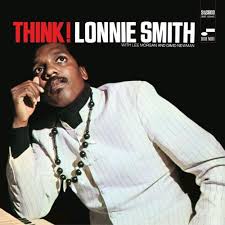 In the world of 1950s hard bop, there is no more prominent bassist than Paul Chambers. The man was absolutely everywhere.
In the world of 1950s hard bop, there is no more prominent bassist than Paul Chambers. The man was absolutely everywhere.
He shows up on an astonishing number of jazz classics, including Miles Davis’ Kind of Blue, John Coltrane’s Giant Steps, Thelonious Monk’s Brilliant Corners, Sonny Rollins’ Tenor Madness and Oliver Nelson’s The Blues and the Abstract Truth. He was a sideman on 200 albums from the ‘50s and ‘60s.
So it’s natural to associate Chambers with a certain kind of jazz – conventional bop with adventurous soloists, always the supporting rhythm man.
Bass on Top turns that convention on its head – and it’s not an easy listen.
Chambers leads on every tune, playing melody and long solos. Credit the bassman for having the guts to try something very different, and Blue Note for supporting an experiment that surely wasn’t very commercial.
But I’m not a fan of Bass on Top. I admire the idea, but not the reality.
Maybe it’s my ears. I have trouble hearing all those low notes. And maybe it’s just an old prejudice. Bass on Top is so far from what I’m used to hearing. I recognize what Chambers is doing – playing the bass as if it were a sax or trumpet. But it feels foreign. I’ve listened several times, but I just can’t connect. The songs are very familiar, but the instrumentation is not.
It’s not all negative. The opening number, Jerome Kern’s “Yesterdays,” is actually moving. It starts almost like chamber music, with Chambers playing with a bow, a long, melancholy statement of the melody. It’s beautiful. Then it moves into standard jazz improvisation, and I feel lost at sea with the long, heavy bass solo.
Chambers uses the bow again on Miles Davis’ “The Theme.” Again, the bass solos leave me cold, but Kenny Burrell’s guitar and Hank Jones’ piano play more prominent roles, and drummer Art Taylor playfully trades phrases with Chambers. It’s joyful. In fact, Burrell is, for me, the album’s biggest selling point. He never disappoints.
But whether it’s a toe-tapper like Charlie Parker’s “Chasin’ the Bird” or the old chestnut “Dear Old Stockholm,” I just can’t warm up to those long bass solos. The band is terrific. The song selection is top-notch. The experiment is absolutely worthy. But the execution leaves me cold.
Rating: 3 stars (out of 5)
Availability: Easy to find
Cost: Around $5 used

 Is there anything new to say about a jazz classic that features one of the greatest two-horn tandems ever to lay down a blue note? How about this: You must own this record. Period.
Is there anything new to say about a jazz classic that features one of the greatest two-horn tandems ever to lay down a blue note? How about this: You must own this record. Period. The “doctor” with the mysterious turban and manic Hammond B-3 fingers is back. And if you think the old man at 73 can’t possibly match the passion and pyrotechnics of the young man at 26… well, surprise!
The “doctor” with the mysterious turban and manic Hammond B-3 fingers is back. And if you think the old man at 73 can’t possibly match the passion and pyrotechnics of the young man at 26… well, surprise! Listening to Think! is pure pleasure – and not just for nostalgic reasons. It is inspired music. The opening cut, Hugh Masekela’s “Son of Ice Bag” is a high-energy 11-minute soul-funk workout. It’s followed by “The Call of the Wild,” 12 minutes of freaky, hot-and-heavy Afro-Cuban rhythms and grooves. And then the title cut – yes, it’s the Aretha Franklin hit song, given a groovy organ-jazz treatment.
Listening to Think! is pure pleasure – and not just for nostalgic reasons. It is inspired music. The opening cut, Hugh Masekela’s “Son of Ice Bag” is a high-energy 11-minute soul-funk workout. It’s followed by “The Call of the Wild,” 12 minutes of freaky, hot-and-heavy Afro-Cuban rhythms and grooves. And then the title cut – yes, it’s the Aretha Franklin hit song, given a groovy organ-jazz treatment.